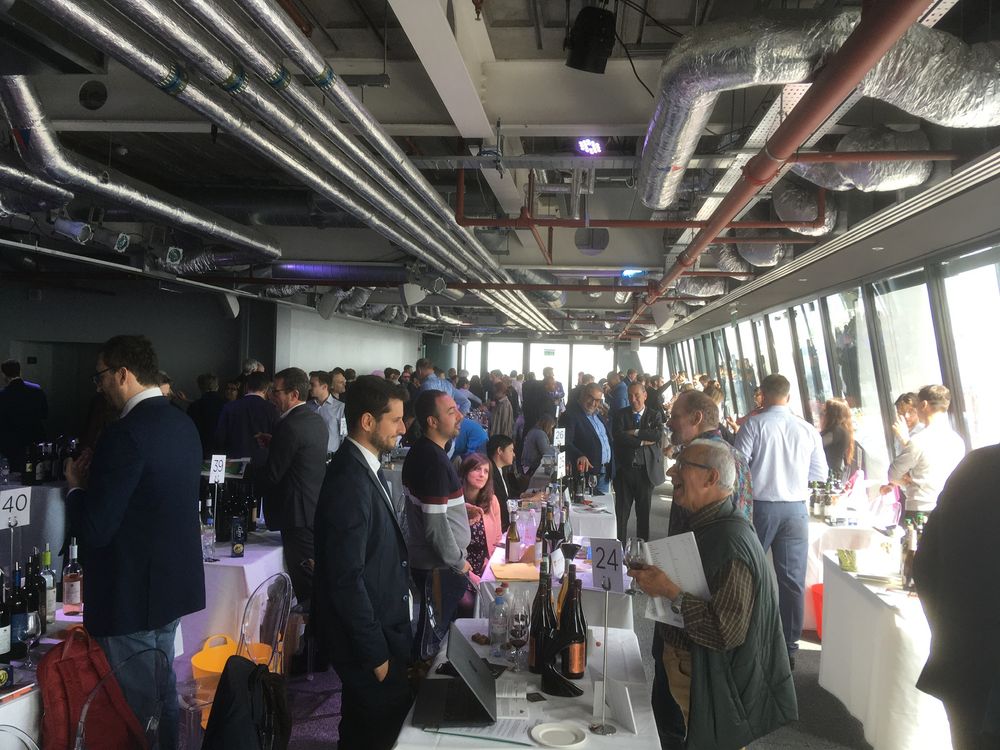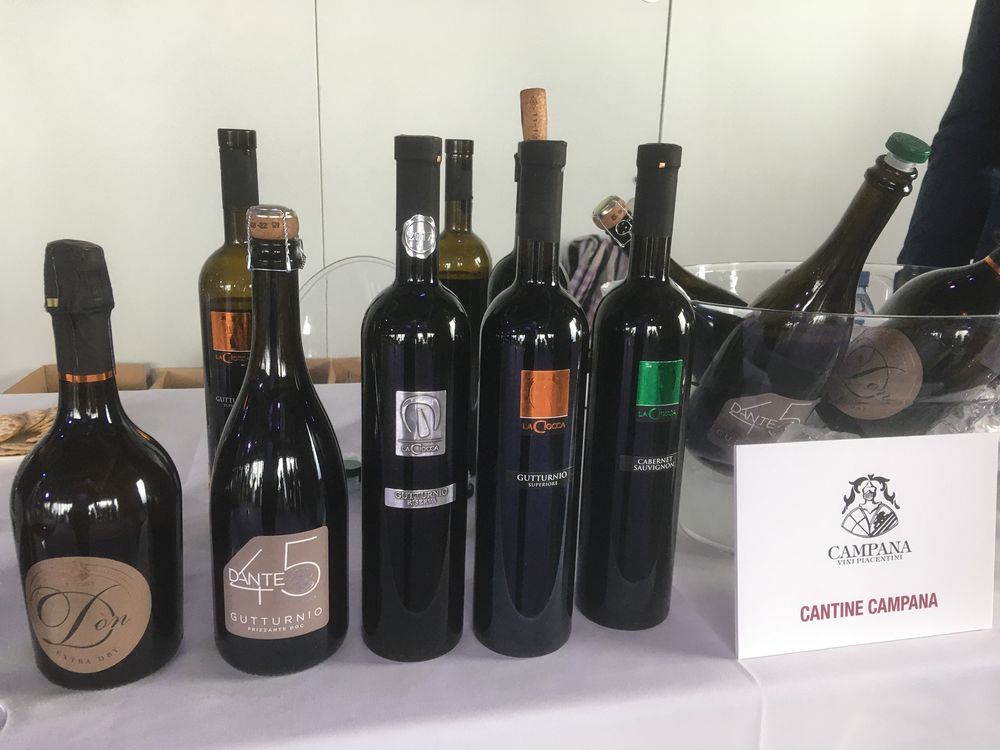“Whatever happened to Frascati? Once it was the only white wine you could find in Rome restaurants, now you can hardly find it anywhere?” asks Keay at Borsa Vini Italiani
People talk of ‘damned lies and statistics’ but when it comes to figures showing UK wine imports, things seem pretty constant: France ships the most, with Italy close behind. With the worst of the pandemic hopefully now past, the Italian Trade Agency seems keen to make up for lost time, with last week’s Borsa Vini Italiani one of a number of events planned to help Italy close the gap.
BVI, which is hosted by the Italian Trade Agency (ITA) is usually a sprawling, busy event and the 2022 edition – held at Landing 42 in London’s Cheesegrater Building, the city’s highest event space, with a dizzyingly fast elevator ride to the 42nd floor – was no exception. Some 50 producers were present from 16 different regions, showing wines made from everything from Schioppettino to Sangiovese by way of Magliocco, Bombino and Cesanese, from wineries mostly unrepresented here.

But this year the ITA is also focused on grabbing a share of the UK’s exploding market for pink wines; although annual sales here have risen five fold over the past five years, to 116m bottles, to date the market has been hogged by France (Provence and increasingly Languedoc) and the pale style beloved by fashionistas, so much so that a darker-shade-of-pale is almost viewed as unacceptable. Until now, frankly, Italian pinks (which thankfully come in a wide range of pink with an equally wide range of taste profiles) really haven’t been a thing here. Which is a shame.
Sarah Abbott MW kicked off proceedings with an enjoyably focused masterclass – “Bella Rosa” –featuring 12 wines – all available in the UK on-trade – from around Italy, chosen on the premise that Vini Rosati have a long and wonderfully varied tradition. The first, the Mezzogiorno 2021 Rosato from the cooperative in Puglia (made from 100% Montepulciano, and available in the UK through Astrum) is very much in the Provence tradition: pale, fragrant and fresh, with gentle maceration, this is a fun, 12% wine likely to appeal to light rose purists everywhere.
Then we went off-piste, with a darker Puglian wine made from Nero di Troia (Paolo Petrilli 2020, Flint Wines) before travelling up and across Italy with different pinks from Piedmont, Tuscany, Sicily, Abruzzo, Veneto and Lombardy.
“These are all really well made, attractive wines,” says Abbott. “The individualistic Italian genius culture, combined with the different DOCs make for excitement too. There is real heritage and enjoyment here.”

Indeed, and my four favourite all tended towards the Dark Side (sorry Darth): the 2021 Aka Primitivo from the Produttori di Manduria coop in Puglia, from 20-40 year old vines, 13% quite chunky and really quite dark from 12 hours skin contact (£15, Alliance Wine); the unusual NV Rosato Svicc from Guido Rivella in Piedmont, made from Nebbiolo, wonderfully bright coloured but saline and high textured (UltraVino, at £35 the priciest wine here reflecting the tiny, 2000 bottle volume); the 2020 Cerasuolo d’Abruzzo from Masciarelli (Les Caves de Pyrenees), 13.5% and quite a big style but really juicy and enjoyable, with some nice sweetness on the palate. Also small volume – 18,500 bottles – but great value at just £12.50. And from Veneto the 2020 Feudo Chiaretto Riviera del Garda Classico, made from Sangiovse, Barbera, Marzemino and Grapello, quite floral but also saline with a nice cherry sweetness on the finish (Lea & Sandeman, £15.50). Four very different but enjoyable, darkish wines – a reaffirming tasting experience.
So what of the 50 producers exhibiting?
Given the sheer scale of this tasting, I decided to focus on a large degree on some of the less obvious regions (so no Tuscany or Veneto and off piste in Piedmont) all underrepresented in the UK on-trade.
Seven Producers from Seven Regions

Stefania Pepe, Abruzzo
Natural wine producers were thin on the ground but this small producer, run by Stefania Pepe, dedicated to “your health and pleasure, our environment and our benefit” was a delightful find, making organic wines from local varieties including Pecorino and Passerina and the less well known Matonico and Cococciola without any added sulphites. The sparkling ancestral method Pepe con Brio 2018 made with seven varieties but Trebbiano d’Abruzzo dominant, was a joy, lots of brioche and peach but as was the extraordinary full-on Cuore di Vino 2006 from the Cerasuolo d’Abruzzo DOC, highly distinctive, cherry and red berry flavours made from 100% Montepulciano d’Abruzzo, 100% biodynamic and slightly cloudy. The 2017 vintage also on tasting was no less impressive. Definitely worth trying as is the Pepe Bianco 2007 made from the same profusion of varieties as the sparkling Brio.
Colacino Wines, Calabria
You don’t see many wines from Italy’s toe which is a shame because there is a whole world of rare varieties down there unused anywhere else, including Pecorello, Greco Blanco and Matonico – all three of which go into Savutro Bianco 2021 from the Savuro DOP, quite light on with floral and herb notes on the palate supported by fine acidity. I preferred the Bianco Quarto 2021 from the Cantabria IGP, a surprisingly hefty blend of 80% Pecorello and 20% Malvasia: full bodied, rich and moreish. But the wine this producer is most famous for, and which tastes, basically of sour cherries, is the Savuto Superiore Britto 2016, first made by Dr Vittorio Colacino before his children took over at the winery. Full on, lots of cherry and wild herb flavours, this is really distinctive.

Cantine Campana, Emilia Romagna
Based in Piacenza, the heart of Bonarda/Barbera country in the Colli Piacentini, this producer focuses on the region’s speciality, Guttornio, which is made sparkling (usually in the frizzante style) or still. Producer Andrea Balboni says he aims for the most authentic and traditional styles and although his Guttornio Frizzante DOC Dante 45, 2021 was very moreish (not unlike a quality Lambrusco) it was the two still wines that caught my attention. The Gutturniuo Superiore DOC La Ciocca 2020 is unoaked but with a dense, remarkably broad palate with a balanced use of 60% Barbera and 40% Bonarda; by contrast the Gutturnio Riserva DOC La Ciocca 2017 spend three years in oak, refined with lots of depth and character. Balboni says this will improve over 15 years.
Gigante, Friuli-Venezia Giulia
I was hard pressed to chose amongst the excellent producers from this region – three others, Grillo Iole, i Feudi di Romans and especially Modeano (a 100% 2020 Malvasia, wonderfully saline with white pepper underlying a complex style) were also impressive, showing a delicious range of wines made from local varieties including Refosco, Ribolla Gialla and Friulano.
But Gigante, established in 1957 near the Slovenia border and working with very old vines (some more than 75 years old, the average around 40 years) just pipped them, thanks to its flagship Fruliano Vigneto Storico 2020 made with those historic vines in the Friuli Colli Orientali DOC, to make a rounded, fruit driven but well balanced wine supported by firm acidity. Other noteworthy wines here include Storico and Friends 2019, a moreish white blend of Fruliano, Malvasia and Ribolla Gialla and the red, spicy, very fruity unoaked Schiopettino Gigante Riserva 2017, made 100% with that variety.

Casale Vallecheiesa Winery, Lazio
“Whatever happened to Frascati? Once it was the only white wine you could find in Rome restaurants, now you can hardly find it anywhere?” I had to ask Bruno Gasperini of Casale Vallecheiesa. His reply was that other regions were smarter than Lazio and focused on making quality wines that the increasingly picky Romans preferred, which probably explains why you seldom find Lazio wines over here either. But this is a great producer, making quality DOC Frascati – try Le Rubbie 2021 a fresh blend of four local white varieties led by Malvasia dei Lazio, or the more complex Heredio 2020. For something non Frascati-ish, Ribello 2020 (Lazio IGP) is a very aromatic, mineral variety grown in local volcanic and tufo soils. Oniro 2020 (Cesanese IGP Lazio), a great medium bodied red, an impressively nuanced take on this oft-ignored variety. Located just 10 kilometers outside Rome, Casale Vallecheiesa makes just 150,000 bottles.
Malvira, Piedmont
Think of Piedmont and yes, you will usually be talking about Nebbiolo. But family-run Malvira is located to the north of Barolo and Barberesco, in Roero (Canale) which means that although they make some great Nebbiolo the main focus here is white Arneis. The Roero Arneis DOCG 2020 is organic and unoaked, showing great expression of the variety with white flowers, honeysuckle and white peach flavours on the palate. The Roero Arneis DOCG Vigna Saglietto 2018 is a very different style, with careful use of oak ageing allowing a more generous wine, rounded and slightly saline with a long finish.

Mandwinery-Ladogana, Puglia
Sometimes you want something a little different and this organic IGP project fits the bill – no Primitivo in sight but instead some wonderful Nero di Troia wines, including notably the Mandwinery Bisciu Rosé IGP Puglia, a nice full bodied slightly off dry, floral rosé that could have sat well in Sarah Abbott’s masterclass, and a very refreshing semi-sparkler, 60 Passi Don Franc 2021, made from 100% Chardonnay, that was so fresh and fruit-forward it seemed to leap from the glass. Not very Puglian I’ll admit, but that seems to be the point here. Quite commercial wines, but none the worse for that.
































